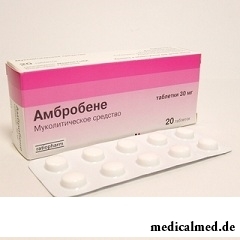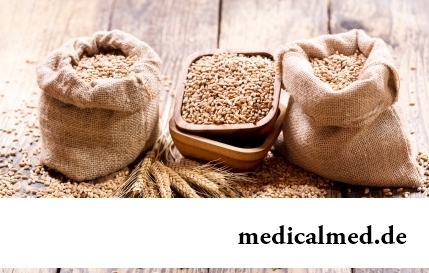





Ambrobene
Application instruction:
 Ambrobene - mucolytic means which has sekretolitichesky, sekretomotorny and expectorant effect.
Ambrobene - mucolytic means which has sekretolitichesky, sekretomotorny and expectorant effect.
Form of release and structure
Ambrobene is made in the following forms:
- Capsules;
- Tablets;
- Solution for injections;
- Solution for inhalations and intake;
- Syrup.
As a part of all forms of drug the operating component is Ambroxol the hydrochloride.
Ambrobene's capsules contain the following excipients:
- Methylhydroxypropyl cellulose;
- MKTs and carboxymethylcellulose of sodium;
- The colloid silicon besieged;
- Triethyl citrate;
- Ferrous oxide (black, yellow, red);
- Gelatin;
- Titanium dioxide.
Capsules are issued in blisters. In one blister – 10 pieces. Packaging contains 1 or 2 blisters.
As auxiliary components in Ambrobene's tablets dioxide high-disperse, corn starch, lactose and magnesium stearate act silicon. In one cardboard packaging 2 blisters on 10 tablets.
Solution for Ambrobene's injections as excipients contains:
- Dinatrium моногидрогенфосфат heptahydrate;
- Monohydrate of citric acid;
- Water for injections;
- Sodium chloride.
Ambrobene's solution for injections is produced in ampoules on 2 ml in a strip packaging. One packaging contains 5 pieces.
Ambrobene's solution for inhalations and intake, except active ingredient, contains the purified water, potassium sorbate and hydrochloric acid. It is on sale in bottles droppers from dark glass on 40 or 100 ml. The measured glass is applied to them.
Ambrobene in the form of syrup contains sorbite liquid, crimson fragrance, the purified water, propylene glycol and saccharin. It is on sale in bottles from dark glass on 100 ml. The measured glass is also applied to them.
Indications to use
According to the instruction, Ambrobene is appointed at the following diseases:
- Pneumonia;
- Chronic and acute bronchitis;
- Bronchoectatic disease;
- Chronic obstructive pulmonary disease, including bronchial asthma with the complicated phlegm otkhozhdeniye;
According to the instruction, Ambrobene can be used and as a part of complex therapy at respiratory a distress syndrome at newborn and premature children for surfactant synthesis stimulation.
Contraindications
The instruction to drug warns that Ambrobene's use should be avoided in the following cases:
- Hypersensitivity;
- Epileptic syndrome;
- Peptic ulcer of a stomach and duodenum;
- Feeding period breast;
- First trimester of pregnancy.
With care Ambrobene is appointed at:
- Serious illness of a liver;
- Renal failures;
- Large volumes of the allocated secret;
- Disturbance of motility of bronchial tubes.
Route of administration and dosage
The route of administration of Ambrobene depends on a release form:
- Capsules (1 capsule – 75 mg of Ambroxol of a hydrochloride). Appoint to children 12 years and the adult in the dose corresponding to 1 capsule in day are more senior;
- Tablets (1 tablet – 30 mg of Ambroxol of a hydrochloride). For adults the scheme of use following: on 1 tablet 3 times a day (the first 2-3 days), then frequency rate of receptions is reduced to 2 times a day, or the single dose decreases to 1/2 tablets with preservation of 3 receptions;
- Solution for Ambrobene's injections (1 ampoule – 15 mg of Ambroxol of a hydrochloride). The adult with frequency rate in 2-3 receptions usually appoint on 1 ampoule, however in hard cases increase in a single dose is possible. The daily dose to children is considered according to the following scheme: 1,2-1,6 mg of Ambroxol of chloride are multiplied by the child's weight in kg. In Ambrobene's instruction the following doses are specified: on 1/2 ampoules to children up to 2 years (2 times a day) and to children from 2 to 5 years (3 times a day), and to children of 5-12 years appoint on 1 ampoule, at frequency rate of use 2-3 times a day. At treatment of a syndrome of suffocation at newborn and premature Ambrobene is appointed in 3-4 receptions, and the daily dose is calculated by multiplication of 10 mg of Ambroxol of a hydrochloride by the child's weight in kg. In hard cases with care the daily dose can be increased by 3 times;
- Ambrobene's solution for inhalations and intake (1 ml contains 7,5 mg of Ambroxol of a hydrochloride). The first 2-3 days the adult appoint drug on 4 ml, at the same time frequency rate of receptions – 3 times, then frequency rate decreases to 2 times with preservation of a single dose, or the dose decreases to 2 ml, but 3 times a day are accepted. To children up to 2 years the single dose equal to 1 ml, it is necessary to give 2 times a day; it is necessary to increase the number of receptions to 3 times with preservation of a single dose to children of 2-5 years; 2-3 times a day are appointed a single dose (2 ml) to children of 5-12 years;
- Ambrobene syrup (5 ml – 15 mg of Ambroxol of a hydrochloride). For convenience of use the measuring glass on which one division corresponds to 1 ml of syrup is applied to drug. For adults the single dose makes 10 ml which the first 2-3 days are accepted in 3 receptions, with the subsequent reduction to 2 times. Also after 2-3 days of treatment reduction of a dose to 5 ml with preservation of triple reception is possible. To children 2 years are younger drug is appointed of 2,5 ml 2 times in laziness, to children of 2-5 years the same dose is appointed 3 times a day, children of 5-12 years should give syrup on 5 ml 2 or 3 times a day.
After Ambrobene's use inside drug begins to work in half an hour, action remains for 6-12 hours.
Ambrobene is allocated with breast milk, gets through hematoencephalic and placental barriers.
Side effects
According to the instruction, Ambrobene can cause the following undesirable reactions of an organism:
- Small tortoiseshell;
- Skin rash;
- Quincke's disease;
- Extremely seldom – allergic contact dermatitis, an acute anaphylaxis;
- Diarrhea;
- Lock;
- Dryness in a mouth;
- Rhinorrhea;
- Headache.
Prolonged use of Ambrobene can make sick, vomiting, a gastralgia. Bystry administration of drug can become the reason of an adynamia, feeling of catalepsy, a lowering of arterial pressure, intensive headache, a hyperthermia, an asthma and a fever.
In case of overdose diarrhea, vomiting, dyspepsia which are eliminated by a gastric lavage or calling of vomiting are possible, reception of fat-containing products can also help.
Special instructions
It is not recommended to combine means with antibechic drugs which complicate removal of a phlegm.
In rare instances Ambrobene's use can cause skin reactions in severe forms (a Lyell's disease and Stephens-Johnson's syndrome). At the changes of mucous membranes or integuments which are observed after administration of drug it is necessary to stop administration of drug and at once to see a doctor.
Analogs
Ambrobene's analogs are the following drugs: Ambrolan; Bronkhoksol; Ambrosan; Deflegmin; Bronkhorus; Ремеброкс; Haliksol; Flavamed.
Terms and storage conditions
Ambrobena needs to store in the dry dark place unavailable to children, at a temperature not above 25 °C.
Drug period of validity - 4 years.
Name of drug
Price
Drugstore
Ambrobene oral.a solution for инг фл 7.5mg/ml 40 ml, Merckle
117 rub.
 Network of the Moscow drugstores of IFC
Network of the Moscow drugstores of IFCThe American scientists made experiments on mice and came to a conclusion that water-melon juice prevents development of atherosclerosis of vessels. One group of mice drank usual water, and the second – water-melon juice. As a result vessels of the second group were free from cholesteric plaques.

Feeding by a breast - the integral part of ideal motherhood allowing to come into contact with the kid and to create since early years...
Section: Articles about health
Aspirin (acetylsalicylic acid) – one of those drugs which are known literally to all. It is available in each home first-aid kit, and many accept it at the first signs of an indisposition, often without having a fair idea of properties and a therapeutic eff...
Section: Articles about health
Healthy lifestyle today in fashion, and many parents think of that the child from the early childhood played sports. Trainings will help it to become strong and hardy, will improve coordination of movements, and also will exert positive impact on mentality: it will become more collected and purposeful....
Section: Articles about health
Partial and the more so full loss of hearing significantly reduces quality of life. Difficulties with communication lead to loneliness and замкн...
Section: Articles about health
An eye of the person daily experiences considerable strain. The problem of preservation of sight is for many years directly connected with a question of supply of tissues of eye enough oxygen and nutrients. This task is carried out by small vessels – capillaries. For holes...
Section: Articles about health
Memory is an ability of the central nervous system to fix, keep and as necessary to reproduce information on knowledge or skills received by the person or an animal during life. The mechanism of this process is up to the end not studied....
Section: Articles about health
People know that thermal sources have salutary force long ago. Treatment by natural waters is one and...
Section: Articles about health
Life does not indulge the modern woman special emotional comfort and carelessness. The fatigue, troubles at work, misunderstanding in a family and various illnesses immediately affect a condition of hair and skin. And to look safe and attractive so хоч...
Section: Articles about health
One of the useful properties presented to the person by the nature is ability to feel fear. This ability is designed to signal about approach of a dangerous situation and to help to avoid in advance it to keep life. However if the fear is persuasive and is not reasonable, it can seriously limit possibilities of the person in respect of socialization and self-realization. Such pathological fear is called a phobia....
Section: Articles about health
Practice of use of table salt in the therapeutic purposes contains not one century. Appl are considered especially effective...
Section: Articles about health
Smoking not only exerts a negative impact on the state of health of the consumer of tobacco products, but is an air polluter the substances potentially dangerous to people around. In recent years significantly the number of people, стремящ increased...
Section: Articles about health
What will only not be thought up by persons interested to have a beautiful figure. Here the last innovation – for weight loss needs to be eaten greasy food. Let's understand whether there is at a fatty diet common sense....
Section: Slideshow
Climax - process of fading of reproductive function of an organism in process of its aging. At women the main sign of its approach showing...
Section: Articles about health
The sclera and mucous membrane of an eye are intensively supplied with blood vessels which problem - to saturate nervous tissues of body with nutrients and oxygen. In a normality vessels are almost not noticeable, however at their expansion (owing to истонч...
Section: Articles about health
Tick-borne encephalitis – one of the most dangerous viral diseases which causative agents transfer and is given to people by ixodic mites. These are the small blood-sicking insects living in the considerable territory of our country. The person bitten by a tick can catch also erlikhiozy, bartonnelezy, babeziozy, mycoplasmosis and Lyme's disease. As well as encephalitis, these illnesses affect the central nervous system, and as specific antiviral therapy does not exist, the forecast very to a neuta...
Section: Articles about health
Season of activity of viral infections in the heat. Everyone can get sick, but probability of this unpleasant event it is possible and it is necessary miny...
Section: Articles about health
A little more than a century ago goat milk was a traditional food stuff of most of Russians. Unfortunately, today on tables of our compatriots it appears extremely seldom. The reason that the use of so useful product practically descended on...
Section: Articles about health
The stroke is one of the most widespread diseases of the person, annually in the world about 6 million cases of this pathology are registered. According to medical statistics, strokes occur almost three times more often than myocardial infarctions. The disease belongs to heavy, and has an unfavourable result: the lethality reaches 40% among women and 25% among men. A considerable part of the patients who endured a stroke cannot be recovered completely. We suggest readers to examine...
Section: Articles about health
The concept "gluten" (differently, a gluten) combines group of the proteins which are a part of rye, barley and wheat. For most of people упот...
Section: Articles about health
Zone hypostases under eyes - very widespread problem giving to people is a lot of inconvenience. Hypodermic fabric in these parts has very loose structure and almost does not contain collagenic fibers. Besides, the skin covering подглазья constantly is exposed...
Section: Articles about health
Neurosis is called pathology of a nervous system at which deviations in functioning of the highest nervous processes are observed. Most often - owing to yet not strengthened mentality - children are subject to neurosises. The unhealthy, hostile atmosphere in collective, a family, the strong and sharp shock, and also a set of other factors which negatively influence the little person who did not learn to overcome stresses yet can become premises to emergence of such disturbances....
Section: Articles about health
On health of the person physicians know about salutary action of animals long ago. About 7 thousand years ago great Hippocrates рекоменд...
Section: Articles about health
The modern person not always manages to find housing in the environmentally friendly region and such work which would not do harm to health. With food stuffs at first sight the situation is much better: shops are overflowed with goods which are positioned пр...
Section: Articles about health
Hemorrhoids – extremely widespread disease. Periodically arising inflammations and bleeding of hemorrhoidal nodes cause serious discomfort to nearly fifteen percent of adults. Meanwhile, having a clear idea of the reasons of an exacerbation of an illness and following rules of precaution, it is possible to reduce substantially sharpness of unpleasant feelings and to reduce progressing of a disease....
Section: Articles about health
About 10-15 years ago existence of the computer in the apartment of the Russian was considered as a rarity and office rooms were only on перв...
Section: Articles about health
It seems, quite recently you brought the baby from maternity hospital, but time flew by, and here it is already going to join the first in life children's collective. How to prepare the child for visit of a garden? What needs to teach him to facilitate process адап...
Section: Articles about health
The name of this disease precisely reflects the problem reason: it consists in the bra fastener pressure upon a certain zone of a back. At the same time one of vertebrae of chest department of a backbone is as if blocked and loses mobility, and the loading falling on it is distributed on the next vertebrae. At 70-80% of women local pains in a backbone point on which the fastener of the often put most on bra presses result....
Section: Articles about health

